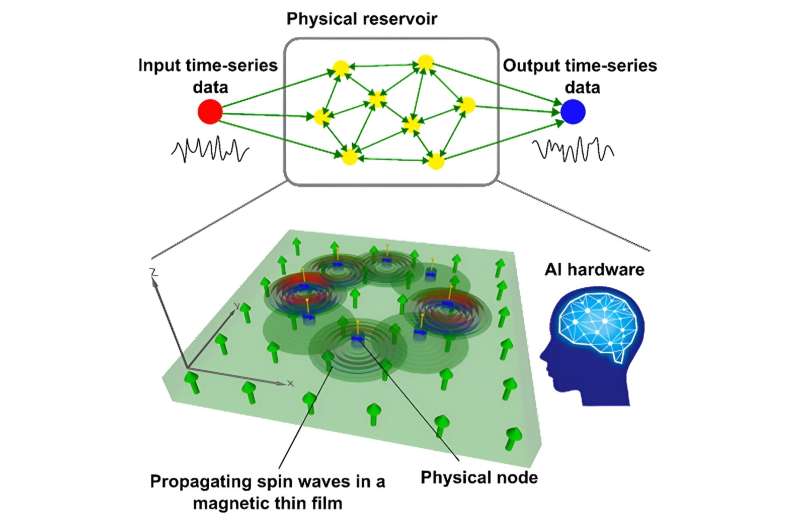This article has been reviewed according to Science X's editorial process and policies. Editors have highlighted the following attributes while ensuring the content's credibility:
fact-checked
trusted source
proofread
Giant leap toward neuromorphic devices: High-performance spin-wave reservoir computing

A group of Tohoku University researchers has developed a theoretical model for a high-performance spin wave reservoir computing (RC) that utilizes spintronics technology. The breakthrough moves scientists closer to realizing energy-efficient, nanoscale computing with unparalleled computational power.
Details of their findings were published in npj Spintronics on March 1, 2024.
The brain is the ultimate computer, and scientists are constantly striving to create neuromorphic devices that mimic the brain's processing capabilities, low power consumption, and its ability to adapt to neural networks. The development of neuromorphic computing is revolutionary, allowing scientists to explore nanoscale realms, GHz speed, with low energy consumption.
In recent years, many advances in computational models inspired by the brain have been made. These artificial neural networks have demonstrated extraordinary performances in various tasks. However, current technologies are software-based; their computational speed, size, and energy consumption remain constrained by the properties of conventional electric computers.
RC works via a fixed, randomly generated network called the "reservoir." The reservoir enables the memorization of past input information and its nonlinear transformation. This unique characteristic allows for the integration of physical systems, such as magnetization dynamics, to perform various tasks for sequential data, like time-series forecasting and speech recognition.
Some have proposed spintronics as a means to realize high-performance devices. But devices produced so far have failed to live up to expectations. In particular, they have failed to achieve high performance at nanoscales with GHz speed.
"Our study proposed a physical RC that harnessed propagating spin waves," says Natsuhiko Yoshinaga, co-author of the paper and associate professor at the Advanced Institute for Materials Research (WPI-AIMR). "The theoretical framework we developed utilized response functions that link input signals to propagating spin dynamics.
"This theoretical model elucidated the mechanism behind the high performance of spin wave RC, highlighting the scaling relationship between wave speed and system size to optimize the effectiveness of virtual nodes."
Crucially, Yoshinaga and his colleagues helped clarify the mechanism for high-performance reservoir computing. In doing so, they harnessed various subfields, namely condensed matter physics and mathematical modeling.
"By employing the unique properties of spintronics technology, we have potentially paved the way for a new era of intelligent computing, leading us closer to realizing a physical device that can be put to use in weather forecasts and speech recognition," adds Yoshinaga.
More information: Satoshi Iihama et al, Universal scaling between wave speed and size enables nanoscale high-performance reservoir computing based on propagating spin-waves, npj Spintronics (2024). DOI: 10.1038/s44306-024-00008-5
Provided by Tohoku University





















